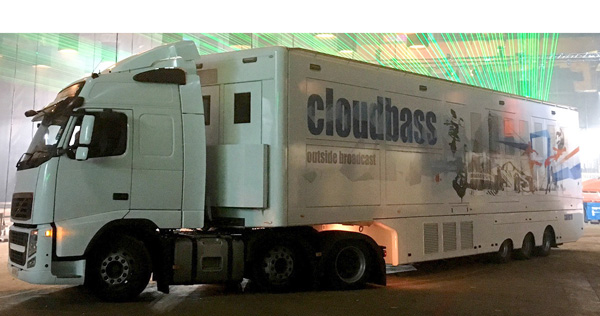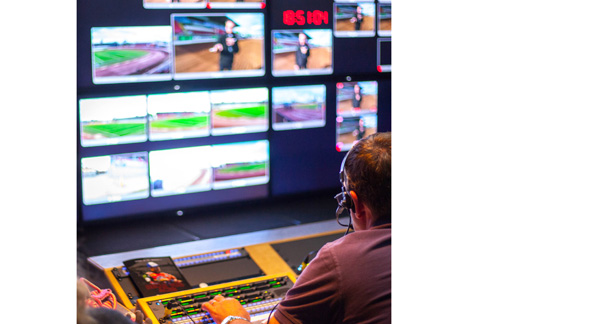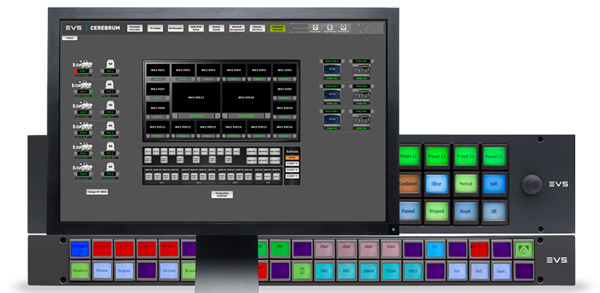Cloudbass built a multivendor full-IP OB vehicle layer they will use to upgrade their fleet, handling formats from SDI-HD to UHD, based on EVS Neuron processing and Cerebrum control.

UK outside broadcast specialist Cloudbass has deployed a multivendor IP OB vehicle equipped to support new 4K-UHD HDR and 8K formats throughout full live production workflows. Using this vehicle’s capabilities, the company has been able to address changing market demand, keep its facilities up to date and stay competitive in the industry.
Cloudbass based their decision to invest in IP infrastructure on the growing market demand for 4K production, particularly in live sports. Seeing the advantages of the flexibility and speed of a full IP workflow, they wanted to build a system they could use to upgrade their existing fleet of vehicles to address multi-format work, from SDI-HD to UHD.
Scalable Full-Ip Layer
They planned to support 4K production by adding a scalable, full-IP layer to their existing and future fleet and set up a configurable, integrated workflow comprising IP devices and software from multiple vendors. For efficiency and flexibility, the operation supports multiple formats and allows for capacity expansion.

Cloudbass Technical Director Michael Beaumont
Any strategy would also have to minimise the risks of moving to a complex IP environment, and protect ROI. To do this, the first step was to work with a systems supplier and integrator who understood their requirements and could help them proactively address issues raised by the SMPTE ST2110 standard.
Cloudbass chose OB9, a 20-camera truck built by systems integrator ES Broadcast, from their fleet to start developing their IP transformation project. Due to a crowded schedule of high-profile events, the timeframe was tight – the truck needed to be back on the road in a matter of weeks.
OB9 is composed of IP hardware and software from manufacturers including Arista, EVS, Evertz, GVG, Ross, Calrec, Riedel and Sony. It uses EVS systems to integrate these systems into a fast, flexible workflow with a future-proof scalable infrastructure that suits live sports coverage.
Processing Control and Monitoring
OB9’s operations are based on EVS Neuron IP processing, with the EVS Cerebrum control and monitoring software to integrate and control its varied systems layers. The flexibility of this system means Cloudbass staff can switch quickly between formats and avoid engineering bottlenecks. It also makes deployment times for clients shorter, and capacities can be expanded if needed.

OB9 features 21 Neuron units, setting up the IP Gateway – nodes for communication between networks – each with processing features such as edge synchronizers and up/down/cross converters. Each unit is able to handle 200 Gb/s and 64 1080p signals or 16 UHD channels with up to 80 SDI connectors, all within a single 1RU.
Neuron accepts streams from any of the equipment in the truck, regardless of the signal packing method or variation of the ST-2210 standard the manufacturer uses, making external processing and glue products unnecessary. Multi-vendor workflows may encounter interpretation issues related to the ST 2110 standard. Also, by running up/down/cross conversion on every path, Cloudbass can deliver any feed required for broadcast without addressing each one individually.
EVS’s Cerebrum control and monitoring software is the critical factor in integrating equipment from multiple vendors within OB9’s workflow. It establishes a high level of control for operators over all equipment through a single GUI, including the routing of NMOS compliant devices. This interface places technical complexity in the background and displays a centralised view of issues and faults. It also speeds up the pre-configuration of the truck, a job that could typically take hours to complete, and now can be achieved in minutes.

EVS Cerebrum
Eight Productions in 40 Days
Cloudbass Technical Director Michael Beaumont said, "With EVS, we covered eight major productions in OB9’s first 40 days, including the UEFA Football Euro 2020 Qualifiers for Sky and ITV’s Rugby X Tournament. Achieving that is a very tall order for a truck-build undertaken in just 12 weeks. But we now have a tested product that works, and a concept that can be transplanted into any of our trucks. This means we can continue to deliver cost-effective services, according to each production, and keep up with new requirements coming up in the future."
While the broadcast market is changing rapidly, Neuron is able to adapt to different environments, whether its functionality is needed in a broadcast facility or in a datacentre. It bridges the gap between baseband SDI and all types of IP media streams, protecting current investments for future demands. evs.com





